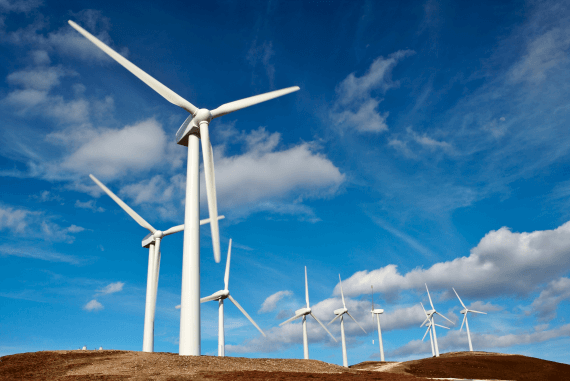- Home ››
- Health and Safety Training ››
- Environmental Health and Safety ››
- Wind Power
Wind Power

People have been harnessing the power of the wind for thousands of years, such as powering sailing ships and turning the blades of a windmill to name just two. In fact, wind power has played a tremendous part in the survival and expansion of the human race over the millennia. Wind powered boats enabled early man to discover new lands and trade with other civilisations, whilst windmills powered the machinery that was used to grind grain for bread production and for powering other machinery through the turning crankshaft. Windmills also were used to great effect in places such as the American West to power water pumps which obtained water from underneath the dry, arid ground for drinking and crop irrigation.
Although many recreational sailors still rely on the wind to move their little vessels through the water, the introduction of the combustion engine and electricity has meant that wind power is not as vital as it once was. However this is beginning to change with the invention of the wind turbine which converts wind energy into electricity by rotating the blades of the turbine. This electricity can then be used to power the machinery and equipment of the modern age, reducing the requirement to obtain electricity from a power station which burns fossil fuels that give off pollutants and gases which harm the environment.
Wind power is a renewable source of energy as it does not have a finite life like other types of fuel such as coal and oil have (there is only a limited amount of coal and oil remaining in the earth, whereas the wind will blow as long as the earth exists).
Disadvantages of wind power as a source of energy
Despite wind power being a clean and unlimited source of power, there are a number of drawbacks and disadvantages associated with its use.
For starters, wind power is similar to solar power in that it is erratic, or more precisely, it is dependent upon the changeable and unpredictable weather. If the wind doesn't blow, the turbines don't spin and no electricity is produced.
The other most significant disadvantage of wind power as an energy source is that it requires a lot of turbines to be constructed to generate the same amount of power as one fossil fuel burning power station can produce. Not only will constructing this many wind turbines be extremely expensive, but will require a large area for them to be built over. This will be a problem in terms of finding the space upon which to build them, especially for a relatively small landmass like the United Kingdom, but will also create outrage amongst numerous members of the public who protest that the large turbines spoil the natural beauty of the countryside. Wind turbines built on land are built on top of the hills and on exposed, open ground where it is windiest, which unfortunately means that they can be seen for miles around. They can also be noisy as the blades spin around which also attracts protest and complaints from nearby residents. Even wind turbines which are built offshore out to sea can spoil the view and be a danger to shipping in the water.
Wind turbines will often be sited quite a distance away from where the electricity they produce is connected to the Grid, which means that there is a requirement for long cables. The length of these cables means that not only is there a tremendous length of cable to inspect if a fault develops, but large energy losses can also be present as the electricity has to travel a long way through them.
Site Suitability for Wind Turbines
It may be an obvious thing to say but wind turbines require wind to turn them. This means that they need to be constructed in a place where they will receive as much wind as possible in order to generate enough electricity to justify the cost of building them. A wind turbine which does not receive much wind and barely turns is of minimal use and will ultimately be just an expensive statue.
The windiest places are those which are exposed (i.e. not in built-up areas) and those which are high up such as on a hill. Unfortunately this creates conflict between the local community and those wishing to build wind turbines or wind farms in the area. This is because exposed hills are found in the countryside where no existing buildings are present, which means they are unspoilt areas of natural beauty, so any construction project whether it is a wind turbine, houses, shopping centre or indeed any other structure is likely to be met with opposition, particularly in a relatively small landmass such as the United Kingdom where available land is at a premium.
To compound the problem, building a turbine on top of a hill will mean that it can be seen for miles around, causing residents spread over a significant area of land to oppose the building as it will spoil the view out of their windows. The same argument also applies to offshore wind farms where a large number of turbines are built off the coast out to sea, as this spoils the coastal view for local residents and visitors to the area. There are also noise concerns associated with certain types of wind turbines too as the blades rotate.
Household Wind Turbines - Advantages and Disadvantages
The increase in environmental education and awareness, in conjunction with rising energy bills, has resulted in numerous households taking advantage of this free source of energy. Saying this, although the wind energy itself is free, it can still be costly to erect and construct a wind turbine. There may also be a requirement to carry out work to increase the structural stability of a roof so that it can support the weight of the turbine upon it, again creating additional expense before the financial benefits of the wind turbine can be enjoyed. The visual impact associated with large turbines mentioned at the top of this page is also apparent on a smaller scale when they are built on private property. As such, planning permission may be required before the turbine is constructed, especially if it is to go on or near a listed building for example.
Visual Impact
Although it may not directly affect the health and safety of people or their wellbeing, developments which have a negative visual impact upon the environment are a major cause of concern for local residents and those who enjoy the scenery and picturesque beauty of an area.
One of the most common reasons for complaints result from the building of wind farms. This is because they need to be built in rural undeveloped areas in order to receive the most available wind to turn the blades, as surrounding buildings would block or disrupt the flow of air. An alternative option is to build them offshore in the sea, however this spoils the view from the coast and is another blot on the landscape. Whilst they produce clean energy which is commendable, for many people the environmental impact that wind farms cause is not worth it for the amount of electricity which they actually produce.
Along with the visual impact caused by wind farms and other methods of electricity generation, operations such as mining can also have a significant visual effect upon their surroundings and the local landscape, as it is necessary to dig and radically alter and disturb the ground above where the mineral deposits are situated. Mining also destroys animal habitats and can cause contamination of the land or pollution of nearby watercourses, which makes it an industry which is carefully monitored by environmental regulators and activists.
Environmental Health and Safety Training
It is more important these days than ever for companies to be aware of their environmental responsibilities and how their actions and operations affect the environment. As such, more and more are putting their employees on training courses in order to increase their knowledge and environmental awareness, with NEBOSH environmental courses such as the NEBOSH Environmental Certificate being amongst the most popular and respected of all. For more information on NEBOSH courses, please click on the "Health & Safety Training" option on the menu at the top of the page.

